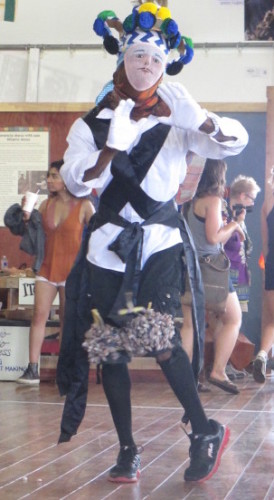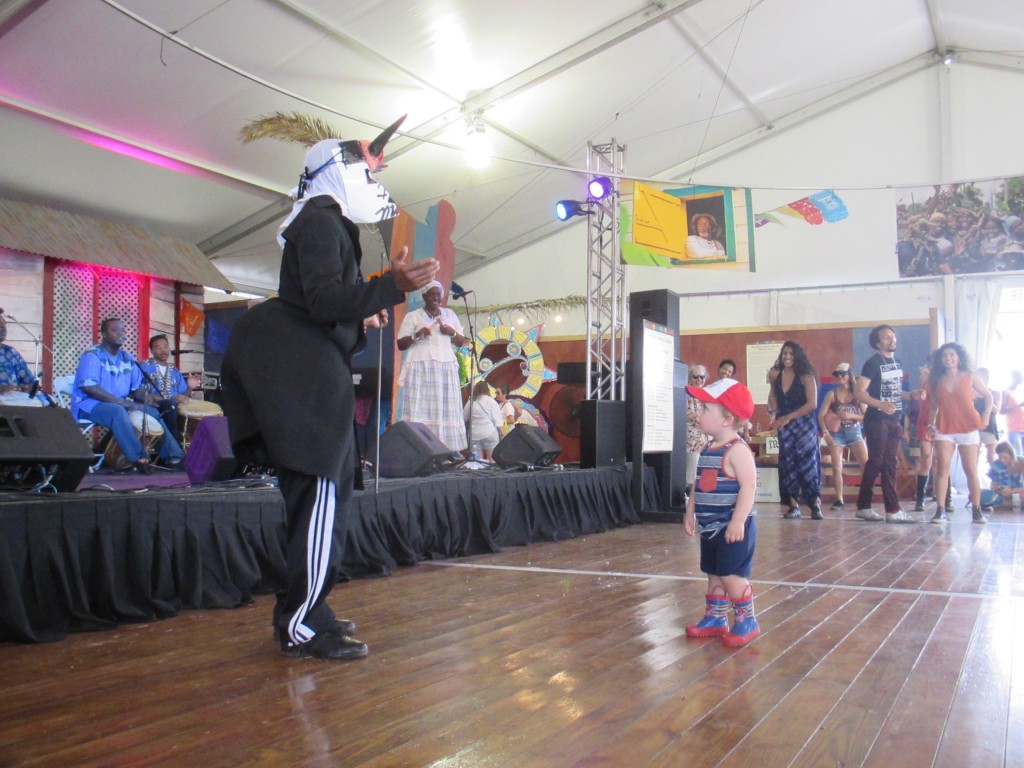A refugee from the Collision conference was suddenly seized by ancestral Garifuna spirits inside the Cultural Exchange Pavilion Friday, madly gyrating across the floor. While four Wageirale Drummers pounded out multiple, overlapping rhythms on traditional hardwood drums and women dressed in costumes sang call and response, he made his way center stage, before coming face-to-face with a dancer wearing a ceremonial mask in the image of a steer. Whoa!

A Charikanari dancer, dressed in Western garb – long-sleeved shirt, white gloves, black knees socks and wire mesh mask with European features, did a Charlie Chaplin-esque dance, mimicking British colonialists.
The crowd gathered in the Cultural Exchange Pavilion at Jazz Fest was captivated by the authentic multicultural Balizean experience. It was possible to detect influences in the performance that originated from Central Africa, Spain, Latin America and Arawak “Carib” Indians more than 200 years ago. Traditional Garifuna instrumentation includes Primero and Segunda drums, Scrapers, Turtle Shell percussion, and acoustic guitar. I, for one, know I definitely heard Nigerian drum rolls similar to those played in my African dance class.
Four drummers each sounding a different rhythm – chunga, paranga, punta and hungu-hungu – kept the energy flowing in endless, melody-less vibration. The lead singer cautioned: “Don’t forget your language — If you don’t know where you’ve come from, you don’t know where you are going.” Garifuna’s rich musical tradition includes many styles, including wanaragua, abaimahani, matamuerte, laremuna wadaguman, gunjai, sambai, charikanari, eremuna egi, paranda, berusu, teremuna ligilisi, arumahani, and Mali-amalihani with the more modern Punta the most popular dance music.
Africans first arrived in 1675 when a slave ship from Bight of Biafra wrecked and survivors escaped to the islands where they intermixed with the Carib people. Descendants bounced around the Caribbean for decades as French and British colonials captured and claimed prime spots for themselves. Finally exiled from St. Vincent, the Garifuna people petitioned to settle on the Spanish mainland – today’s Honduras, Guatemala, Nicaragua and Belize. New Orleans also has many residents who’ve immigrated from Belize.
Andy Palacio (1960-2008) devoted himself to spreading Garifuna culture, touring the world to promote Garifuna music, and Paul Nabor (1928-2014) popularized paranda, a traditional style that flourished in Central America. At Jazz Fest, Natividad and Rose Obando created a “Dia de Los Finados,” Day of the Dead altar, to honor them.
Perhaps they were the spirits who infused the conventioneer.
 NOLAbeings Multimedia artist Claire Bangser created NOLAbeings as a portrait-based story project that marries...
NOLAbeings Multimedia artist Claire Bangser created NOLAbeings as a portrait-based story project that marries...  Voodoo in New Orleans: Reviving history: New Orleans fortune telling This article takes a deep dive into the history of Voodoo in New Orleans, its hybridization with Catholicism, and its present-day place in the city's culture. The author visits fortune-tellers in the French Quarter, using their guidance as a tool for introspection rather than a deterministic predictor of the future. Through her experiences in New Orleans, the author feels a mystical connection to both the past and the future.
Voodoo in New Orleans: Reviving history: New Orleans fortune telling This article takes a deep dive into the history of Voodoo in New Orleans, its hybridization with Catholicism, and its present-day place in the city's culture. The author visits fortune-tellers in the French Quarter, using their guidance as a tool for introspection rather than a deterministic predictor of the future. Through her experiences in New Orleans, the author feels a mystical connection to both the past and the future. 